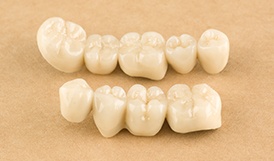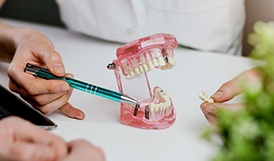Dental Bridges – Framingham, MA
A Better Way of Bridging the Gap in Your Smile

If you’re missing one or more teeth, dental bridges offer a proven, natural-looking way to restore your smile and improve everyday function. Designed to fill the gap left behind by missing teeth, bridges can renew your confidence, protect your oral health, and help you chew and speak comfortably again. At Framingham Premier Dental, we create beautiful, customized dental bridges that blend seamlessly with your natural teeth. Schedule your consultation today to find out if a dental bridge is right for you.
Why Choose Framingham Premier Dental for Dental Bridges?
- High-Quality Materials for Beautiful, Long-Lasting Results
- Skilled Dentist with Several Years of Experience
- Insurance-Friendly and Financing Options Available
What is a Dental Bridge?

A dental bridge is a custom-made restoration that literally bridges the gap left by one or more missing teeth. It typically consists of one or more artificial teeth, called pontics, anchored in place by crowns on the surrounding natural teeth or by dental implants. Dental bridges can be crafted from materials like porcelain, ceramic, or metal alloys for strength and a natural appearance.
Types of Dental Bridges

The right type of bridge for you depends on your specific needs, goals, and oral health. During your consultation, Dr. Gaitsgory will examine your teeth and gums, discuss your options, and recommend the type of bridge that will offer the best long-term results for your smile.
Traditional Dental Bridges
A traditional dental bridge is anchored by dental crowns placed on the natural teeth adjacent to the gap. This type of bridge is durable, reliable, and can quickly restore both the function and appearance of your smile. It’s a time-tested solution that can last for many years with proper care.
Implant Bridges
Implant bridges are supported by dental implants instead of natural teeth. Dental implants are small titanium posts placed into the jawbone to act as artificial tooth roots. With this option, there’s no need to alter the surrounding teeth, and implants also help preserve bone density in the jaw, making them a stable, long-term solution.
The Benefits of Getting a Dental Bridge

Leaving a gap in your smile can lead to a variety of issues, including teeth shifting out of place, changes in your bite, and increased risk of gum disease or tooth decay. Missing teeth can also make eating and speaking more difficult and take a toll on your self-confidence. A dental bridge can address these problems by restoring your bite, preventing movement of surrounding teeth, and giving you a smile you’re proud to share.
Dental Bridges FAQs
Do Dental Bridges Look Natural?
Our team only uses materials designed to look exactly like natural teeth, so you can expect your dental bridge to blend right in with the rest of your smile. We can construct your prosthetics with porcelain or ceramic, both of which appear similar to real tooth enamel and mimic the ability to reflect light. After your bridge has been placed, the results should be tailored specifically to your unique smile to allow for a proper bite. While dentures rely on your gum line or metal clasps, your dental bridge will be anchored to your abutment teeth with dental cement, meaning you won’t have to worry about them shifting out of place.
How Long Should a Dental Bridge Last?
In general, the majority of modern dental bridges can usually last 5 to 15 years before needing to be replaced. Of course, their exact lifespan will depend on various factors, including your oral hygiene, dietary choices, and whether you have bad oral habits or not (such as nail-biting, teeth grinding, chewing ice, or smoking). The location of the dental bridge in your mouth can also impact how long it lasts, as those placed in the front tend to last much longer than those in the back due to them not having to withstand as much pressure from chewing.
Is a Partial Denture the Same as a Bridge?
Partial dentures are NOT the same as dental bridges. Some people may refer to them as “removable bridges,” but this can cause some confusion. While both options are designed to help rebuild missing teeth, traditional partial dentures are usually designed to be removed at any time, especially overnight, whereas dental bridges are meant to remain in place indefinitely. The only reason your prosthetic should be removed is when your dentist does so. Furthermore, dental bridges are typically best used for patients who are missing one to three teeth in a row, whereas partials can replace missing teeth in various places across your dental arch. Our team will discuss which option is best to help you regain a full bite.
What Can You Not Eat with a Dental Bridge?
With dental bridges, you’ll be able to enjoy most of your favorite foods with an improved bite. Of course, you’ll still want to be careful with certain kinds of items that can ruin your restorations. To help your bridge last as long as possible, you’ll want to avoid sticky foods that can cause your prosthetic to loosen out of place, such as gummies, sticky candies, caramel, and candy apples. Be sure to also minimize how often you consume sugary drinks and foods, as you’ll want to avoid developing cavities around your dental bridge.

